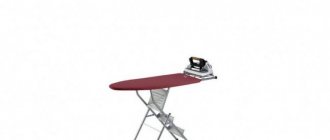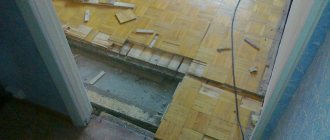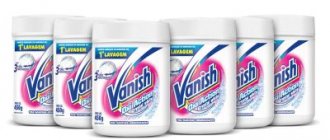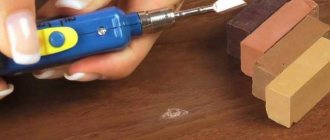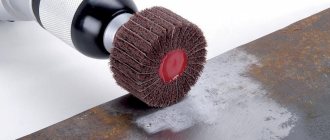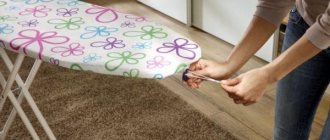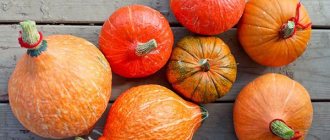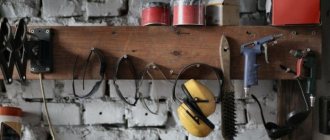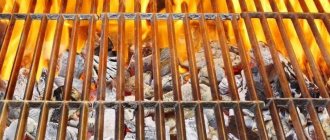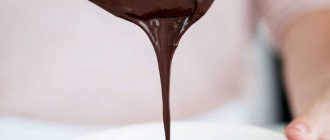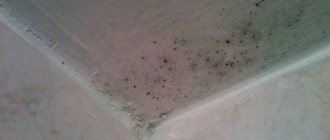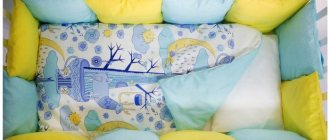Why soak cutting boards?
Mineral and petroleum jelly compositions are the most effective when processing products. With his help:
- foreign odors are not absorbed;
- fungi, bacteria, mold do not appear;
- there are no mechanical damages.
The liquid is absorbed by the pores, forming a protective layer. Processing algorithm:
- The dry board is sanded.
- The composition is applied with a sponge over the entire area and on the sides.
- After 20 minutes, remove with a napkin.
- Treat once every 3 months.
- A new product is treated before first use.
- Cover three times.
- The break between layers is up to 12 hours.
Why is beeswax added during processing?
Paraffin.
By adding beeswax, the ointment becomes more effective. Wax has the quality of a sealant that protects pores from water. Thanks to it, resistance to moisture appears.
A product without bee composition does not contribute to the appearance of a protective film. Wax clogs pores and crevices. The protective layer prevents the penetration of moisture, food residues, and dirt.
How to prepare the mixture at home
If you were unable to buy the necessary impregnation for the boards in the store, you can easily make it at home, with your own hands. The simplest recipe is:
- buy Vaseline oil at the pharmacy,
- buy beeswax in a specialized store,
- combine 4 parts butter and 1 part wax, cut into pieces,
- melt the mixture in a water bath, stirring to ensure homogeneity,
- cool the product to room temperature,
- Use for wood processing, store in the refrigerator.
It is undesirable to replace beeswax with paraffin or stearin - the latter strongly clog the pores of the wood, which seriously impairs its vapor permeability and can provoke rotting.
Are other finishing compounds hazardous to health?
This question still causes heated debate, despite the fact that clear and authoritative answers have long been given to it. To finish wood products in contact with food, you can use any finishing compositions, including oil-based, polyurethane and nitrocellulose varnishes, shellac coatings and linseed oil. These materials are completely harmless to health, but only after complete drying. This is a very important point!
Before you start using any kitchen board that you decide to paint with one of these compounds, you need to make sure that the coating is completely cured. Remember that the presence of a surface film does not mean that the composition has completely dried inside the wood.
Plywood cutting board
Plywood is a lightweight material, it does not deform under high temperatures, is durable and easy to use. For a household cutting board, you should not choose a moisture-resistant one, as it is impregnated with synthetic resins.
Manufacturing Guide
The following materials are useful for making plywood products:
- drill;
- jigsaw;
- grinder;
- rasp;
- milling machine.
The main work in the manufacture of plywood boards is carried out with a jigsaw. The cut along the marked contours must be done with a smooth and continuous stroke of the tool for subsequent quick processing of the ends.
Unlike wooden boards, decorative carvings are not made on plywood. The original design is achieved through the contour lines of the product, so the shape should be thought out and drawn on the sheet in advance.
Upon completion of cutting:
- sand the product;
- get rid of chips and irregularities using a rasp and sandpaper;
- remove chips and refine the ends with a milling machine.
Finally, the product should be finally sanded with fine-grained sandpaper, the non-working surface should be coated with varnish, and the working side and ends should be rubbed with wax.
What is mineral oil
Mineral oil is crude oil or is produced from industrial crops. The following types of oils are used to impregnate wooden products:
- coconut;
- linen;
- woody;
- consisting of several ingredients;
- mineral.
Mineral oil, which is a product of petroleum refining, is used to treat wooden cutting boards. The synthetic product is absolutely safe, therefore it is used in cosmetology, medicines, and the food industry. Mineral oil is available as edible or non-edible. For wooden utensils, including cutting boards, a food safe product is suitable.
The oil is very popular due to several positive characteristics:
- high level of protection;
- lack of smell and taste;
- ease of application;
- environmental Safety;
- quick drying;
- combination with other coatings;
- lack of color unless it contains special additives.
Oil not only prevents rapid wear and tear of the product, but also gives it shine and a pleasant appearance.
Step 3. Applying the composition to wooden products
I took a tablespoon of oil for a medium-sized cutting board and spread it all over the surface with my hands. The warmth of the hands melted the oil, and it was well absorbed into the wood.
I then left the treated wooden utensils for 12 hours to allow them to absorb the oil well.
The next day, I used a soft cloth (or maybe a paper towel) to remove anything from the surface that wasn't absorbed (but usually the oil is completely absorbed). The result should be a pleasant, smooth surface with a slight shine.
The remaining oil (closed with a lid, of course) can be stored at room temperature for a long time, for example, for the next processing.
Bought at the pharmacy
We bought mineral oil at the PHARMACY...
WHAT kind of oil is this?
I would advise you GOST 3164-78 Vaseline oil. RuChef mineral vaseline oil is an excellent tool for sharpening knives and caring for a wooden cutting board. Vaseline oil is a traditional cutting fluid used for manual sharpening of knives. Many branded sharpening oils consist of petroleum jelly. Proper care of your cutting board will prevent cracks, mold and germs from appearing, and will extend its service life for many years.
This is especially important for end grain wood cutting boards. Mineral oil is odorless and tasteless
It is absolutely safe for humans. When you purchase a new wooden cutting board, immediately treat the wooden surface with mineral oil. This procedure must be repeated regularly as the oil dries. Oil fills the pores of the wood and prevents the penetration of liquids and food particles. Wipe the board with mineral oil and let it soak in, then remove any remaining oil with a dry, clean cloth. Don't be afraid to apply too much oil - in this case, more is better. Wipe your cutting board with oil at least once a month. Complies with GOST 3164-78. Shelf-life Unlimited.
Why is processing needed?
During operation, the cutting board is subjected to enormous loads. It is scratched by knives, water, juice from cut foods, blood, and also cleaning agents used to wash dirt off the board get into the pores of the wood. Therefore, the service life of untreated wood is no more than a year. At the same time, boards made of beech, birch, pine, and oak are not cheap.
During processing, the oil fills the natural pores of the wood. This solves the following problems:
- The development of unwanted microorganisms in the tree: mold fungi, putrefactive bacteria, etc. Microorganisms that settle on the board can not only spoil food, but also get into the food, causing health problems. Therefore, treatment is necessary to make the board safe to use.
- Excessive swelling and deformation of wood from water. This problem is especially relevant for plywood cutting equipment. Penetrating between the layers of veneer, moisture causes delamination. Impregnation protects the pores from water entering, preventing deformation.
- Chips and cracks. When wood dries out, it becomes brittle. Protective impregnation prevents moisture from completely leaving the pores.
That's why kitchen utensil manufacturers almost unanimously recommend treating cutting utensils.
Primary processing must be carried out immediately after purchase. Even washing the board once will saturate it with water, and the protective composition will “lock” the water into the pores. Such a board will be much heavier, and it is excellent for the development of putrefactive bacteria.
How to evaluate the quality of mineral oil
When choosing mineral oil, there are certain requirements for the product
You should pay attention to the following quality parameters:
- Safety. The product must not release toxins when used. This is especially true for wooden products that are located in rooms with an unstable microclimate (high humidity, temperature fluctuations).
- Depth of penetration into the wood structure. Oil must be absorbed, unlike varnishes, glazes and a number of impregnations.
- Water-repellent qualities. A low-quality product will lead to rotting and rapid deterioration of products.
- The ratio of mineral and natural oils. It is desirable that the percentage of natural components be higher.
- Vapor permeability. High-quality oil should not create a film on the wood, since the main advantage of wood disappears - the ability to “breathe”.
- Transparency. As a result of application, the high-quality composition does not change the appearance of the wood (structure, color, pattern). But if you wish, you can add safe colors that will paint the surface of the object in the desired color.
- No smell. If the oil does not smell of anything, then it contains a minimal amount of chemicals.
How to oil a cutting board?
Oil for impregnation is applied to a well-polished and dried surface. Having evenly distributed a generous amount of finishing composition using a brush or swab, it is allowed to absorb into the wood structure (15-20 minutes), after which the excess is wiped off by running the swab along the fibers.
A new wooden cutting board is treated with at least two or three layers. Each fresh layer of oil is applied after the previous one has completely dried. This is not very convenient, since the polymerization rate of vegetable oils is quite low. Drying the boards must be done in a well-ventilated area.
What is mineral oil
Mineral oil is crude oil or is produced from industrial crops. The following types of oils are used to impregnate wooden products:
- coconut;
- linen;
- woody;
- consisting of several ingredients;
- mineral.
Mineral oil, which is a product of petroleum refining, is used to treat wooden cutting boards. The synthetic product is absolutely safe, therefore it is used in cosmetology, medicines, and the food industry. Mineral oil is available as edible or non-edible. For wooden utensils, including cutting boards, a food safe product is suitable.
The oil is very popular due to several positive characteristics:
- high level of protection;
- lack of smell and taste;
- ease of application;
- environmental Safety;
- quick drying;
- combination with other coatings;
- lack of color unless it contains special additives.
Oil not only prevents rapid wear and tear of the product, but also gives it shine and a pleasant appearance.
How to choose depending on the board material?
It is clear that boards are different. They are made from plywood, oak, pine, beech and other wood. Any oil you decide to use will only benefit the product if it is used correctly.
- Pine boards treated with flax seed oil may develop an unpleasant, bitter odor over time.
- Some markets have quite profitable promotions when boards are sold immediately with impregnation in a set. This is a very good offer, since the manufacturer has already selected the composition that is suitable specifically for this wood.
- Vaseline oil is suitable for any type of wood.
- Oak is the most durable, strong and reliable option. Wax is often used to process it. This combination will help give the product durability and allow it to be used for many years. But the impregnation needs to be updated from time to time.
As you can see, there are no difficulties in processing wooden cutting boards. The main thing is to purchase the right oil, which will preserve not only the appearance of the product, but also its quality.
Why soak cutting boards?
Mineral or petroleum jelly is considered best for impregnating cutting boards. The oil has no odor or taste, it will not go rancid and will not spoil the taste of food. Thanks to mineral oil, the board is reliably protected from the following troubles:
- absorption of unpleasant odors;
- the appearance of microbes, mold, mildew, harmful microorganisms inside the wood;
- the appearance of cracks and chips due to the dryness of the material.
You should treat a new, never used cutting board, and then periodically renew the impregnation. Before applying the product, it is necessary to prepare the product. The board should be dry and its surface well sanded, without roughness. The liquid is distributed over all surfaces and ends using a brush or swab. You need to apply generously, for 15-20 minutes, then remove the excess with a swab, moving it along the fibers. If the board is new, then the treatment is carried out in 2-3 layers - each new layer is applied after the previous one has completely dried. Drying of the impregnation lasts from 10 to 12 hours.
How to properly impregnate
If the board is new, it is immediately treated with oil in 2-3 layers, with each subsequent one applied only after the previous one has been absorbed. Drying utensils is done in a well-ventilated area. The old board is pre-prepared: carefully sanded with the finest sandpaper to remove all large roughness. The product is thoroughly dried - not even a small amount of moisture should remain inside the wood.
After drying the board, apply oil generously with a brush, cotton swab or gauze swab over the entire surface and from the ends, after 20 minutes the excess is wiped off. Movements are carried out only along the fibers of the material. Apply impregnation in 2-3 layers 10-12 hours after each previous one.
Plywood boards also require special care. Unlike solid ones, they are made from thin sheets of wood glued together, and therefore are more sensitive to moisture. If done incorrectly, plywood boards quickly swell and mold settles between failures.
Such products are treated with mineral oils with the addition of beeswax, applying the product with a roller or a soft brush, after laying the board in a horizontal position. This work is carried out at least once a month.
To make a wooden cutting board last longer, follow these tips during use:
- after each use, the utensils are washed with a minimum amount of detergents, any remaining moisture is wiped off with a towel, then dried thoroughly,
- do not allow the board to remain in the water for a long time,
- depending on the intensity of use, the board is treated with oil once every 2-5 months,
- a product heavily damaged by knives is first ground, polished, giving it smoothness, and only then subjected to oil impregnation.
If you do not ignore the rules for caring for wooden boards, regularly treat them with high-quality oil and always dry them, you will not have to spend money on buying expensive utensils. The board will remain safe for health, functional and beautiful, transforming the interior of the kitchen!
How and with what to clean a cutting board
If the cutting board is very dirty, then ordinary table vinegar can be used for disinfection. You should treat the wooden surface with a cloth soaked in vinegar and rinse it. The same disinfecting effect can be obtained by using lemon juice.
By the way, at public catering establishments, in accordance with sanitary and epidemiological rules, the deck for chopping meat is cleaned and salt is added at the end of the day. This prevents the proliferation of pathogenic bacteria. Therefore, cutting boards can be cleaned with salt. You can successfully combine cleaning a wooden board with lemon and salt, as shown in the video.
It is better to refrain from cleaning the board with various cleaning powders and pastes, since there is no complete certainty that detergents will not remain in small cuts, and from there they will not get on the processed products.
Practicality and durability
There are two main requirements for a wooden tabletop: it must be practical and durable.
Advantages of wood:
- Eco-friendly, safe to use and dispose of.
- Natural color enhances any interior.
- Pleasant tactile sensations from warm natural material.
- Ease of making different shapes.
- Never goes out of style.
- Natural wood fits into almost any kitchen style.
Flaws:
- Requires careful care.
- Easily damaged.
- Fire hazardous.
- Expensive.
- Heavy in weight.
The durability of a wooden tabletop depends on the source material and manufacturing method.
Its features:
- dense wood;
- resistant to mechanical damage and stress;
- the composition contains gum - a natural antiseptic that protects against mold, mildew, and prevents the process of rotting;
- When temperature changes, it releases and absorbs moisture.
Solid surfaces are subject to curvature. Glued wood, that is, assembled from several plates, is as flexible and elastic as possible.
Practicality is due to resistance to moisture, temperature changes, and strength.
The nuances of processing plywood boards for cutting food
Plywood boards are made from glued together sheets of wood. The material and glue are not resistant to moisture. The product swells and mold forms.
Such utensils require careful handling. It is necessary to protect from glue and moisture. Mineral oil with the addition of beeswax is suitable for this. Algorithm:
- Treat with a soft brush or roller. Which oil to choose for processing.
- Impregnate in the direction of the longitudinal fibers.
- The device is placed horizontally.
- The new board is opened 3 times.
- Each layer is dried for up to 12 hours.
- The remaining composition is removed with a napkin.
- Impregnation is done once a month for the purpose of prevention.
Types of funds and selection rules
You can coat the cutting board with synthetic and natural oil, the main thing is that it does not contain toxic components and is absolutely harmless to humans. The oil must be resistant to high temperatures (hot water), not deteriorate under the influence of room temperatures and not go rancid: otherwise the cutting board will smell unpleasant.
Tips for selecting impregnations are as follows:
- Do not lubricate pine boards with products based on linseed oil due to poor compatibility of the materials;
- oils that are produced by the same manufacturer and are sold as a set are well suited for treating utensils;
- mineral compositions are often sold in building materials stores, and not all of them are suitable for food purposes;
- It is better to lubricate the most durable oak boards with a mixture of mineral oil and wax;
- thin plywood boards also require oil treatment; natural impregnations are well suited for this purpose.
Vegetable oils
Traditionally, natural oils are used for processing wooden products - sunflower, olive, walnut, linseed, sesame and others. Their main advantage is environmental friendliness and complete safety for health. But any vegetable oil for processing boards has a significant disadvantage - without adding preservatives, it deteriorates and acquires a rancid taste and smell.
The reason is the increased production of butyric acid by butyric acid bacteria, the inhabitants of the product, which gives such a taste. Some products deteriorate after just a couple of months, while others take about 9-12 months to develop a painful “aroma.”
Vegetable oils take a long time to dry. It is better not to pick up the board for two or three days - it will greatly stain everything and leave oil stains. As a result, it will take more than a week to apply several layers of impregnation. Some people choose drying oil for work, because it is also cooked on the basis of oils, but its drying time is not much shorter, and wears out quickly.
Mineral oils
The best oil for impregnating the board is mineral oil. Any synthetic products are made based on petroleum products, while special impregnations for kitchen boards are thoroughly cleaned, becoming safe. Here are their advantages:
- lack of smell, taste;
- Availability in any dishware store, pharmacies;
- the ability to apply a thick layer (everything is absorbed);
- optimal protection;
- long service life;
- ease of operation;
- lack of color;
- improving the appearance of the product.
Popular mineral oils
Many manufacturers produce similar products
In order not to make a mistake and purchase a truly high-quality composition, you can pay attention to the following brands:
- Hard Top Oil-265. Mineral oil from Italy with a long service life, great wear resistance, completely safe for humans. Suitable not only for kitchen boards, but also for knife handles and weapon butts.
- RuChet-100. Inexpensive Russian oil based on petroleum products and petroleum jelly. Used to protect wooden boards from moisture, bacteria, fungi, dryness and cracking. Also suitable for lubricating knives and impregnating plywood products.
- Belinka-135. The oil has a high penetration depth and gives wood objects a pleasant shine. Lasts a long time and does not require frequent application.
Beeswax
Natural wax is considered a natural sealant with antiseptic and antifungal properties. It can be used independently or added to oils, as it increases the moisture resistance of wooden products by clogging too large pores.
Wax literally seals cracks, chips, and small cracks, seriously increasing the life of cutting boards. It is distinguished by its ability to create a stronger protective film than oil can do, and it also gives things a pleasant smell.
Other means
To prevent damage to wooden boards, you can use a natural oil rare for middle latitudes - coconut. It contains a large amount of fat, but retains its properties for a long time and does not become rancid even at room temperature. Cocoa butter has approximately the same qualities, although the price of these products is quite high. You can also use Vaseline oil to treat kitchen boards: it is cheap and sold at any pharmacy.
Overview of the main options
We will talk about some of the most popular and effective methods of carrying out work, each of them has its own pros and cons. Therefore, in the end you will still have to choose a specific solution.
Traditional methods
These are the simplest options, which, nevertheless, can provide fairly high-quality protection, sometimes they can be even more effective than special compounds.
Let's talk about the solutions that are used most often:
- Nowadays, the option of recycling machine oil is very widespread, here the process is very simple: you take the oil that is drained from the car when it is replaced, and a brush with which this composition is applied to the wood. Of course, the appearance of such a finish is not very attractive, but the efficiency is quite high. The main thing is that before treating the boards from mold and mildew, you need to clean them of dirt;
- Many people, when considering the question of how to treat boards against rotting if they are located in the ground, choose the option with hot bitumen. Although this method is fraught with difficulties, because you need to melt the resin and smear it on the wood, the result will be excellent - the surface will be completely covered, and moisture simply will not be able to penetrate it. A more modern option is, they are more expensive, but the reliability is much higher;
You are the happy owner of a beautiful wooden cutting board. It's time to learn how to care for it in order to extend its service life for many years. Proper care of your cutting board will prevent cracks, mold and germs. And it doesn’t matter whether the board is new or old.
After purchasing a new cutting board, immediately treat the wooden surface with oil to protect it from moisture, bacteria and food odors. This procedure must be repeated regularly as the oil dries. Oil fills the pores of the wood and prevents the penetration of liquids and food particles.
What oil can I use?
Any oil that meets two requirements will do: safe for humans (for oral use) and resistant to spoilage at room temperature. Please note that vegetable oils (for example, sunflower and olive) do not meet the second requirement, since they deteriorate over time, regardless of the degree of purification. A cutting board soaked in such oil will acquire an unpleasant smell of rancid, spoiled oil after 1-2 years. It is impossible to get rid of this smell, and the board will have to be thrown away.
Mineral oil
It is best to use mineral oil for prevention, which can be purchased in our store. Mineral oil has neither odor nor taste. It is absolutely safe for humans.
Wipe the board with mineral oil and let it soak in, then remove any remaining oil with a dry, clean cloth. Don't be afraid to apply too much oil - in this case, more is better. Wipe the board at least once a month.
Beeswax
Beeswax is often added to mineral oil to add density. For centuries, wax has been used as a sealant to protect against moisture in making baskets, fabrics, storing food and other perishables, and for caring for wood. Wax increases moisture resistance (although it still does not make the wood waterproof) and helps protect the cutting board from wear and water. Wax remains on the surface, filling pores and crevices, while oil is absorbed into the wood and cannot create such a protective film. A layer of wax prevents moisture, bacteria and dirt particles from penetrating into the wooden surface. In addition, after waxing, the board becomes smooth and pleasant to the touch, and acquires a delicate and pleasant aroma.
You can also buy ointment for boards, consisting of beeswax and mineral oil, in our store. Its consistency is similar to butter. Apply a layer of ointment to the board, rub it with a dry cloth, then let it dry a little and then polish the board until it shines.
Other means
For prevention, you can use a number of vegetable oils, which have a very high price, but are certainly good for health. Coconut and flaxseed oils contain high amounts of saturated fat, which means they won't spoil for years. They do not need to be refrigerated, but direct sunlight should be avoided.
Types of impregnation oils
There is a large selection of oils for impregnating wood on the market. They can be divided into two large groups - mineral and natural. Let's take a closer look at them.
Mineral
They gained great popularity not so long ago due to active scientific and technological development. Then it became possible to create mineral oil with the required characteristics. About 50 years ago, transformer oil began to be used for wood processing. Of course, this is not its direct purpose. The result proved the opposite, which brought sales of transformer oil to a new level. With its help, it is possible to prevent putrefaction of the tree, maintaining its original appearance. Undoubtedly, the production of this product violates environmental standards. Therefore, more and more enterprises give preference to natural oils or at least combine them with mineral ones.
Natural
Natural oils appeared much earlier than mineral oils. It took time to realize their advantages in wood processing. The spread of natural oils was hampered by the high cost of raw materials. However, modern production methods solve this issue.
Their key advantage is their plant origin. Natural components and the absence of harmful compounds make natural oil safe for humans. The most common types of natural oils for impregnating wooden products:
- Wood oil. One of the very first products that protect wood from rot, water and termites. Suitable for impregnation of floor and ceiling finishes, wooden furniture, trim and tableware.
- Teak oil. A universal product suitable for impregnating both internal wooden surfaces (floors, ceilings, decor, stairs, railings) and external ones (facades, gazebos, furniture and garden figures). The best choice for oak, beech and other expensive wood species. Ingredients: tung and linseed oils, purified turpentine.
- Tar oil. Has pronounced antiseptic properties. Ingredients: stump resin, turpentine, linseed oil. Turpentine helps to better saturate the material. Flaxseed oil stops the composition inside. Widely used in the courts. It is used to treat the bottoms of boats and piers. Suitable for exterior treatments.
- It is deservedly considered the most inexpensive and effective means of protecting wooden surfaces. Flaxseed oil has a high hydrophobic ability, so it fights dampness well. The particles penetrate into every pore of the material, emphasizing the structure and “preserving” it. Suitable for processing indoor and outdoor structures.
- Tonic oil (toning). This type of oil is produced on the basis of condensed plant lipids, which restore natural grace to the tree and protect it from destruction. It will also be possible to avoid problems such as fading, cracks, and drying out. More suitable for outdoor use, as the composition deeply penetrates the wood, literally repelling dirt.
Rules for caring for a wooden cutting board
Nowadays boards are made from various materials: glass, wood, stone, plastic, bamboo, olive. Each of them has both advantages and disadvantages. Therefore, you should know the rules for proper selection and how to properly care for them so that they do not become unusable after a few days.
Made of wood
Cutting boards made from this material have been popular since ancient times. The advantages are low price, knife blades do not dull, bacteria form less, and are durable. But it is worth considering that products of this type cannot be washed in the dishwasher. For longer preservation you need to know about some rules:
- After use, it must be rinsed immediately and dried thoroughly.
- To remove strong stains, do not soak the board, but pour a little salt and soda on it and rub with a slice of lemon.
- To avoid deforming the item, it should be stored on a horizontal surface.
- For deep cuts, the surface must be sanded with sandpaper.
- You need to oil the cutting board with beeswax or Vaseline oil every six months.
- It is advisable to store wooden products in a ventilated room and not in a closet. Do not leave them wet or in the sun.
- If a strong aroma remains after use, you can remove it with a vinegar solution or kitchen soap.
- If it is heavily soiled, it can be scrubbed with coarse salt.
Made from bamboo
Such boards are practically no different from wooden ones. However, they contain several advantages: they are stronger, more durable, much less stained and scratched, resistant to damage, are not afraid of moisture, and are environmentally friendly. They can also be used as hot mats. They are quite easy to care for:
- Always wash cutting boards with soap;
- do not leave them in water for a long time, as this may cause them to simply fall apart;
- After washing, wipe dry;
- To ensure that dyed products do not leave marks, the surface must be treated with linseed or mineral oil. This will help create an oil barrier against all stains.
The disadvantages of this material are that it is overpriced, manufactured in small sizes, and is of lower quality than surfaces made of polypropylene and hardwood.
Made of oak, walnut
These cutting boards, made from hardwood, look more beautiful and more expensive. Therefore, these species are trusted much more. They do not absorb moisture, do not stain, are durable, and do not dull knives. But they are much more expensive, do not tolerate moisture, drying out and high temperatures, and require more attention. The care rules for them are the same as for ordinary wooden ones.
From olive
This tree contains a large amount of natural phytoncides and repellents. That's why they are called antibacterial. The structure is similar to quite hard rubber. When you press a knife on such a board, there are no traces of cuts; its material seems to crumble under pressure. They need to be cared for in the same way as wooden ones.
How to properly wash a wooden cutting board
It is not recommended to soak a wooden board in a sink, as the wood gets wet, delaminates, and the board begins to deteriorate. In addition, when soaked, unpleasant odors can be absorbed into the pores of the wood, especially if the board is lying in a mountain of dirty dishes. After such soaking, the board may even begin to mold.
You need to wash the board as follows:
- After cutting each product, the board should be wiped with a damp cloth. Then it won't get too dirty as you prepare your food.
- At the end of use, apply dishwashing detergent to a clean cloth and rub the board with a small amount of water, without dipping it under water or holding it under the tap.
- Then wipe again with a clean, damp cloth to remove the detergent. Try to use chemical-free detergents.
- We wipe the board with a dry towel and put it in its place.
How and with what to process a cutting board
To make a wooden cutting board look attractive, not absorb various unpleasant odors, and to prevent the growth of bacteria, it must be treated with mineral oil and wax.
You may ask me: “Where can I get mineral oil?” The answer is - at the pharmacy.
Ordinary petroleum jelly is mineral oil itself. Although it is produced from oil, it is completely harmless to human health. It is used internally as a medicine. Therefore, it is ideal for processing cutting boards.
To process the board, you need to prepare oil and a cloth. Pour oil onto the board and rub the oil in with a cloth in a circular motion. Don't be afraid to add extra oil. Wood will absorb as much as it needs. This way you will close or, one might say, seal the pores in the wood and bacteria, sticks and all sorts of other bad things will not rage in them. This coating will also have waterproofing properties.
A new board should be treated with oil twice, at intervals of several hours, so that the oil is well absorbed. Simply remove excess oil that has not been absorbed with a cloth or paper towel.
Next, the wooden board can be treated with a mixture of mineral oil and wax. In our city, I bought wax at the market from a seller selling honey.
The recipe for the product is not complicated. You need to take one part wax and 4 parts Vaseline oil.
Heat the oil in a water bath and dissolve the wax shavings in it. To speed up the process, you can heat the mixture in the microwave.
Before the procedure, the cutting board can be slightly warmed up in the microwave (if it fits there). Next, cover it on all sides with the prepared mixture with a brush or clean cloth. Allow the mixture to absorb and harden.
Impregnation with a mixture differs from impregnation with just oil - it is considered more durable and strong, it can close not only pores, but also small cracks and cuts. This treatment of a wooden plank must be repeated periodically - at least once every three months.
If this article was useful to you, then you can share it with your friends by clicking on the social networking buttons below or add the article to your bookmarks.
Treating the board with oil
First of all, the board must be inspected to understand how the wood fibers are arranged. Impregnation must be applied along the fibers.
We recommend: How to collect and dry fireweed to preserve its beneficial properties?
Based on their structure, wooden products are divided into several categories:
- Made from cross cuts of wood. This end board is easily recognized by its pattern, reminiscent of growth rings on a stump. End boards are heavier and stronger, and their price is usually higher than other varieties.
- Boards made from longitudinal cuts are called side boards. They are lighter and cheaper than end ones. On them, the fibers form parallel lines running across the movements of the knife during operation.
- Set products, or Butcher Blocks. They are glued together from small blocks made from end grain wood.
Having decided on the type of product, select the appropriate impregnation. These are either mineral or vegetable oils.
Vegetable oils
Traditionally, all peoples used oils obtained from plants to process wood:
- olive,
- sunflower,
- flaxseed,
- sesame,
- grape seeds, etc.
However, today vegetable oils cannot be called ideal for processing cutting boards. They have two significant disadvantages:
- Vegetable oil will go rancid over time. Butyric acid bacteria, eating the nutrients in the oil, produce butyric acid, a substance with an unpleasant odor and bitter taste. Therefore, over time, a product impregnated with a natural composition will begin to smell unpleasant.
- Long drying time. Within 2–3 days, the treated board will stain everything it comes into contact with. Considering that the impregnation is applied in 3–5 layers, the processing process will last for several weeks.
If you definitely want to use vegetable oil, choose flaxseed oil. It practically does not deteriorate.
Another type of impregnation is drying oil. This is vegetable oil cooked with special additives that speed up drying. But even it takes a very long time to dry.
Mineral oils
Petroleum products are becoming an alternative to vegetable oils. They are called mineral oils. Not all mineral impregnations are suitable for treating kitchen utensils. It is worth choosing either special liquids for treating cutting boards (for example, this composition is sold at IKEA) or Vaseline oil. The last option is the most accessible - it can be bought at any pharmacy.
We recommend: How to save money without switching to bread and water?
To give the oil the optimal consistency, it is mixed with natural beeswax. The base is heated in a water bath, and then small (cherry-sized) pieces of wax are added. The mixture is stirred until homogeneous.
The optimal ratio of oil and wax is 4:1.
The prepared mixture is cooled to room temperature. Now everything is ready to go.
